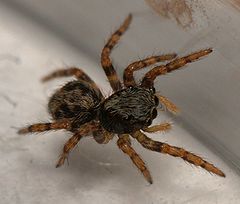
Pseudeuophrys lanigera
Encyclopedia
Pseudeuophrys lanigera is a species
of jumping spider
that is distributed throughout Europe
.
 Males reach a body length of three to four millimeters, with females up to five mm. This species is very similar to Pseudeuophrys erratica
Males reach a body length of three to four millimeters, with females up to five mm. This species is very similar to Pseudeuophrys erratica
, which is rarer and found below the bark of trees on forest fringes. As P. lanigera is mostly found inside buildings, adults can be found even in deep winter. It is better suited to the dry climate of modern concrete architecture than other salticids in the area like Salticus scenicus. Adults can be found the whole year.
A first find in Romania
was published in 2007, and in Poland
the first find was in 1999.
Originally this species was distributed in Southwest Europe, and was first found in Germany in the 1950s, where it is now found only in or near human dwellings.
Species
In biology, a species is one of the basic units of biological classification and a taxonomic rank. A species is often defined as a group of organisms capable of interbreeding and producing fertile offspring. While in many cases this definition is adequate, more precise or differing measures are...
of jumping spider
Jumping spider
The jumping spider family contains more than 500 described genera and about 5,000 described species, making it the largest family of spiders with about 13% of all species. Jumping spiders have some of the best vision among invertebrates and use it in courtship, hunting and navigation...
that is distributed throughout Europe
Europe
Europe is, by convention, one of the world's seven continents. Comprising the westernmost peninsula of Eurasia, Europe is generally 'divided' from Asia to its east by the watershed divides of the Ural and Caucasus Mountains, the Ural River, the Caspian and Black Seas, and the waterways connecting...
.
Description

Pseudeuophrys erratica
Pseudeuophrys erratica is a species of jumping spider that is distributed throughout Europe, although it is not common. P. erratica is normally found under the bark of trees or under rocks on forest fringes. The very similar looking P...
, which is rarer and found below the bark of trees on forest fringes. As P. lanigera is mostly found inside buildings, adults can be found even in deep winter. It is better suited to the dry climate of modern concrete architecture than other salticids in the area like Salticus scenicus. Adults can be found the whole year.
Distribution
P. lanigera is distributed in western and southern Europe, eastward to the Caucasus. In Germany this species is most often observed inside houses, or on the external walls of buildings, indicating it is synanthropic at least in some parts of its range.A first find in Romania
Romania
Romania is a country located at the crossroads of Central and Southeastern Europe, on the Lower Danube, within and outside the Carpathian arch, bordering on the Black Sea...
was published in 2007, and in Poland
Poland
Poland , officially the Republic of Poland , is a country in Central Europe bordered by Germany to the west; the Czech Republic and Slovakia to the south; Ukraine, Belarus and Lithuania to the east; and the Baltic Sea and Kaliningrad Oblast, a Russian exclave, to the north...
the first find was in 1999.
Originally this species was distributed in Southwest Europe, and was first found in Germany in the 1950s, where it is now found only in or near human dwellings.
Biology
P. lanigera has been observed feeding on booklice such as Liposcelis.External links
- Photography of male P. lanigera
- Natur in NRW: Wollige Mauerspringspinne (in German)

